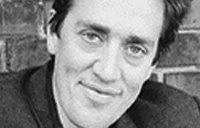On March 4, York’s Canadian Writers in Person course and lecture series presented author Michael Winter reading from his novel The Death of Donna Whalen. Special correspondent Chris Cornish (BA Hons. ’04, MA ’09) sent the following report to YFile.
“I hope what we have here is a story that is respectful to those who recognize, or had to experience, the true events within this fiction. Readers should judge this book as a work of documentary fiction and not a recreation of fact, though I do hope this selected and rearranged narrative reveals some truths about people and their predicaments without altering the essentials of the events that led up to, and followed, the death of Donna Whalen.”
from The Death of Donna Whalen
by Michael Winter

Michael Winter recalls his father telling him the story of the time he nearly drowned while returning from an island moose hunt. There was a storm, the small boat capsized, and despite struggling to swim to the surface, something was dragging him down. He realized that he was tangled in the anchor rope and that it might turn out to be the death of him. Thankfully, his father’s friend dove down, unwound him from the line, and brought him back to the surface. Apart from his father’s near-death experience, Winter was fascinated by the idea that an object that normally represents safety could become a source of danger. “This is the kind of material that I like, how difficult situations arise from an otherwise normal course of events.” This idea of danger arising from ordinary lives is prevalent in his novel, The Death of Donna Whalen, which explores the real life story of a murder in St. John’s, Newfoundland.
According to Winter, the extent of crime in St. John’s prior to this murder was “the guy next door who would sell you counterfeit $50’s, or the guy who shoplifted steak from a grocery store and tried to sell it in the local bar”. A bit of the city’s innocence was burned away after the murder in which the woman was stabbed 31 times, presumably by her boyfriend the prime suspect. Winter had long been haunted by this event and subsequent to the murder became intrigued by the criminal mind. In one of his first jobs (creating radio scripts that explained legal matters in more familiar language), he observed many court proceedings. He noted that criminals often don’t believe they’re breaking the law while many witnesses have no trouble airing their dirty laundry as long as it doesn’t connect to them to the crime. Furthermore, he found that sometimes investigators pursue an accusation, doing everything they can to fit the evidence around their prime suspect, only to find years after conviction that the guilty party was innocent. This shiftiness of “truth” underpins Winter’s “documentary fiction”.
However, writing about “Donna Whalen” presented some challenges. Though he changed the names of the victim and the people involved, Winter still felt he might be exploiting their story and struggled with how to present it. Even the choice of “death” rather than “murder” in the title was a much-deliberated decision because he didn’t want to lyricize the event. After trying a conventional narrative approach, he opted for removing himself from the telling of the story, and changed it from first person to third person narration in order to create even more distance. He also didn’t make up any words, using only those he found in the court transcripts, a hefty task which involved taking a pile of records that measured nine feet high and whittling its three million words down to 70,000. Creating the novel became a form of creative erasure, though Winter admits that his editing choices still end up reflecting his own writing voice.
 On the topic of writing, Winter uses account passbooks, free at most banks, to take notes. They’re pocket-sized and unlike fancy moleskin journals, not “too pretty to write in”. This allows him to write on the spot in a dramatic fashion, capturing his immediate perceptions because for him hindsight is often the death of creativity. In cases such as Donna Whalen, where he already knew the outcome of the trial, the trick was in pretending he didn’t know what was going to happen.
On the topic of writing, Winter uses account passbooks, free at most banks, to take notes. They’re pocket-sized and unlike fancy moleskin journals, not “too pretty to write in”. This allows him to write on the spot in a dramatic fashion, capturing his immediate perceptions because for him hindsight is often the death of creativity. In cases such as Donna Whalen, where he already knew the outcome of the trial, the trick was in pretending he didn’t know what was going to happen.
Yet, “the big doubt is always there: am I a writer?” He nonetheless finds it satisfying to articulate who people are and give that to a character, drawing from the lives of the people around him, something he insists is an act of love. As a writer, “in the house of love, there’s a spy, and you’re it”. Winter also has many of his own experiences to draw on: like the time he anonymously called a local politician to shame them for not singing the national anthem in the rain; or the time he tossed a piece of Labradorite into one of the Egyptian pyramids to confound the archaeologists; or the time he fell into a garbage incinerator and survived. True story.
The Canadian Writers in Person series of public readings at York, which are free and open to the public, is also part of an introductory course on Canadian literature. It is sponsored in part by the Canada Council for the Arts. See the Sept. 15, 2013 issue of YFile for a full schedule of upcoming writers.


